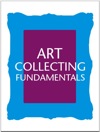Chapter 2 - The First Steps to Collecting
04/01/10 16:05
The first and most important step to take on the road to building your collection is to find out what you like. This may seem like an easy matter for attraction is visceral, you like it or you don't, you feel it in your gut. However, there is more to it than that. To become discriminating in your tastes you must experience what is out there, expose your eye to the myriad ways people see the world and express their creativity. That way you hone in on what really reaches your core.
Art collecting is like any endeavor in that the deeper you go, the more interesting the subject becomes. You can take an art appreciation course at your local college or university but there are other ways to study the history or evolution of art. The beauty is—knowledge doesn't have to cost anything.
There are many books on art to be discovered at your local library and low cost books can be found in the remainder bins at bookstores, often at a fraction of their original cost. Museum entry fees are usually affordable and there are often "free" days as well. Museum gift shops have a wide variety of art books for sale, and exhibition catalogs are wonderful to collect in themselves. An internet web search (Google is good for art) will yield a plethora of information on art movements, artists, and special exhibitions.
Even if your preference is for contemporary art, it is important to know how we got here from there. It's not that you must be able to pass a test on what movement was in what year, or what master painted what, but exposure to information both written and visual will contribute to your body of knowledge and influence your standards in a positive way.
The important thing is to start looking at art—a lot of it. There are many places to see a variety of art, and while books and the internet have their role, there is nothing like experiencing the work up close and personal—feeling the vibe, examining the texture, absorbing the mood, almost tasting the colors.
Browsing in art galleries has no price and allows you to experience work from the commercial to the edgy. Combing newspapers for news of art related exhibitions and events can provide you with a road map to discovery. Visits to college and university exhibitions often reveal student work worthy of note. Art and craft fairs, county fairs, municipal exhibitions and even charity fundraisers can contain surprises. Artists’ guilds or collectives and estate sales and auctions are also fertile hunting ground. You may even find art that moves you being painted by the side of the road or at the beach.
As a practical matter, you can begin your collection by buying just two or three pieces a year, perhaps to mark such occasions as birthdays or anniversaries. It will all add up over time.

